You Won’t Find Blueberries On This Tree
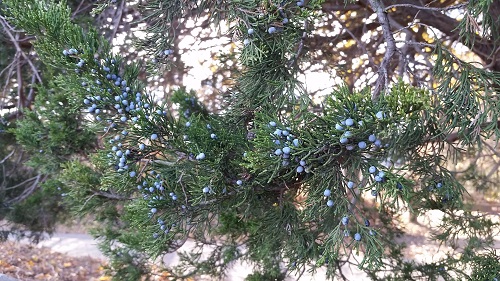
They may look like delicious blueberries but these round objects are actually cones, growing on an Eastern Red Cedar. Inside the fruity flesh will often be one to three seeds. Cedar Waxwings will often eat these Juniper Berries, and in doing so actually increase the new plant’s germination rate. Did you know? These seed cones have traditionally been used to flavor gin. (posted 11/28/2017)
It was a Great Summer for Monarchs at the
Manasquan Reservoir Environmental Center
This summer staff and volunteers at the Manasquan Reservoir Environmental Center raised 172 monarch butterflies from eggs and caterpillars collected from the site’s butterfly garden. These eggs and caterpillars were given daily care and lots of milkweed to eat. Milkweed is the host plant of the monarch and as such is the only plant that the monarch butterfly will lay its eggs on and the caterpillar will eat. Staff and volunteers released each butterfly within hours after emerging from its chrysalis.
Then in September, when monarchs migrate through the region, staff and volunteers began “tagging” these butterflies as part of a citizen scientist project through MonarchWatch.org. This project gives scientists data about how far a monarch migrates, where it came from, its sex, and its condition. Each tag is a small 1/4” diameter sticker that adheres to the hindwing of the butterfly. It has a specific number, the email address for monarchwatch.org, and a phone number to report if found. The Environmental Center tagged 75 monarchs this year. (posted 10/27/2017)
Hey, Is That Goldenrod or Is it That Other Plant Goldenrod?

Autumn, what a wonderful time of year! Apple cider, cool crisp nights, and everything under the sun is pumpkin flavored. With autumn comes a dazzling array of colors displayed all around us. And you needn’t only look to the trees for the show. I am talking about wildflowers, goldenrod to be precise! It seems as if people back in the day started calling any yellow flower in autumn a goldenrod. Did you know, there are over 100 species of goldenrod native to North America? The exact number changes all of the time as researchers debate whether certain goldenrods are truly a different species, or just a variety of an existing one. The next time you pass by a meadow or notice some weedy goldenrod growing along a path, take note of the differently shaped leaves, stems, and flower arrangements. Here at Huber Woods Park, you can find at least five different goldenrod types within a thirty minute walk around the meadows.
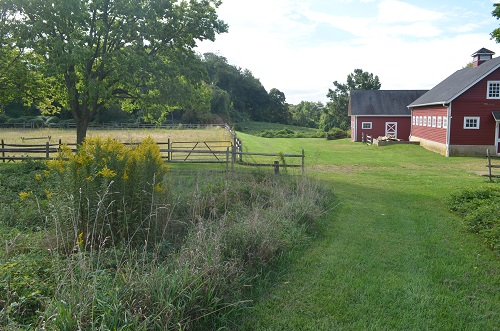
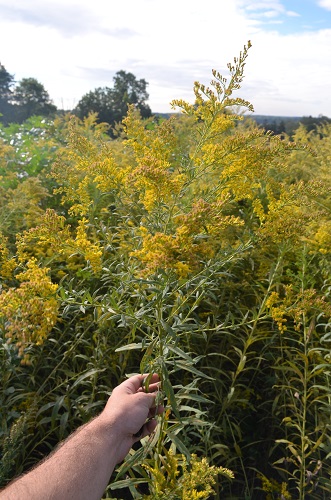
Solidago Canadensis, or Tall Goldenrod
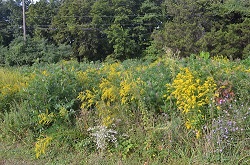
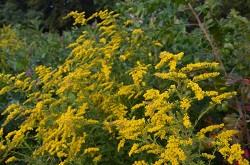
Solidago rugosa, or Rough Goldenrod (Known for vibrant hues)
P.S. - Goldenrod is often blamed for causing fall allergies but due to a very low pollen count, point those accusatory fingers over towards ragweed! (posted 10/26/2017)
Why Do Leaves Change Color in the Fall?
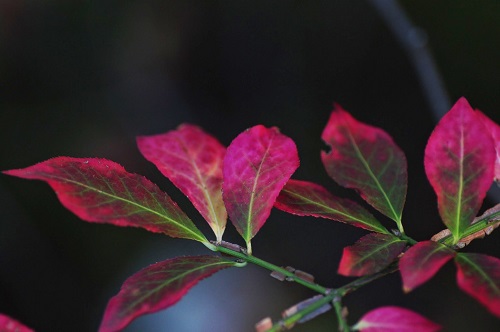
Pictured - Winged Euonymus or Burning Bush (Euonymus japonica) is a common landscape plant but can also be found in the wild and is considered invasive.
While some governors swear the leaves in their state change color to support tourism, reality is stranger than fiction. In order to answer what seems like a simple question, we need to first understand why leave have different colors to begin with.
Leaves use sunlight to power the system that makes the sugar, or food, they need to survive. To make the most sugar possible, they collect all the sunlight they can. Of the rainbow of colors in sunlight, plants only use blue, green and red light as energy. The plant need to ‘catch’ each color of light and the nets it uses are pigments (colors) within the leaves. Each color of light needs a specific pigment to catch it. Orange and yellow leaf pigments catch blue light. Red pigment catches blue and green light. Green pigment, however, is the most prevalent because it catches the most energetic light color, red, thus getting the most energy possible. Because it is the dominant pigment, plants look green even though they have the other colors too.
Trees, other than evergreens, drop their leaves in winter when they go dormant and don’t need to make food. When the tree cuts off water to the leaves, the highest energy-needing pigment “dies” first and the leaves lose their green. After green, the yellow recedes followed by red. Finally the leaf turns brown, dies and drops. Different species have different color concentrations of pigments and that is why they are different colors after the green fades.
So now you know. Without the green color hiding the orange, yellow and red pigments, the leaves look like they have changed colors. In reality, these fall colors were always there waiting for their chance to shine! (posted 10/12/17)
To Eat or Not to Eat
I am often asked about the identity of mushrooms along the trails. The next questions is ALWAYS “Is it edible?” And, while sometimes I am sure that the specimen in question is edible, I usually say that I don’t know. This is because there are so many mushrooms that look alike that I don’t want to chance saying yes and being wrong. Almost every mushroom hunter I know has eaten something that they shouldn’t have and they will all tell you to be safe rather than sorry. That said, there a few edibles that can’t be mistaken for anything other than what they are. Three of these are shown below and all can be found at this time of year. Another option is to try your hand at growing your own mushrooms. If this is of interest, register for Cultivating Mushrooms Workshop on Sunday, October 7, 2017. You will go home with a log infected with different kinds of mushrooms that are guaranteed to be delicious!
Laetiporus sulphureus: The Chicken of the Woods
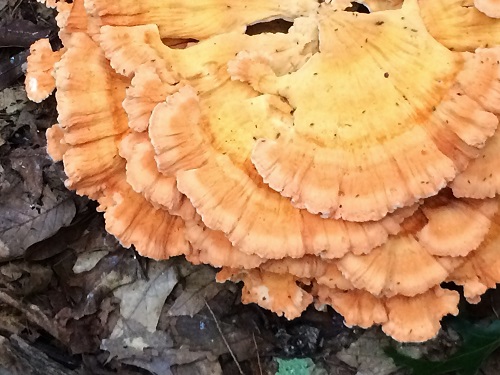
This large, orange-yellow fungus is the most brightly colored one I know. It’s ruffled ‘shelves’ can be found growing in rosettes on the ground or from the base of trees.
Calvatia gigantean: The Giant Puffball
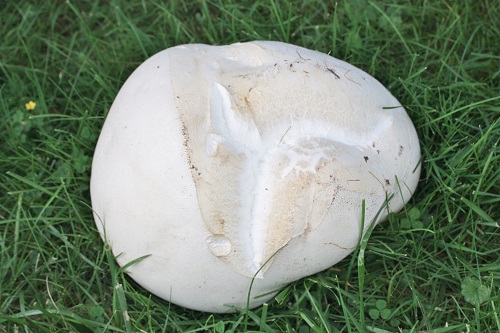
This puffball is regularly seen in grassy areas and grows very large. This one, on the lawn at Thompson Park caught my eye because I thought it was a soccer ball that had been left behind in a field.
Strobilomyces "floccopus": The Old Man of the Woods
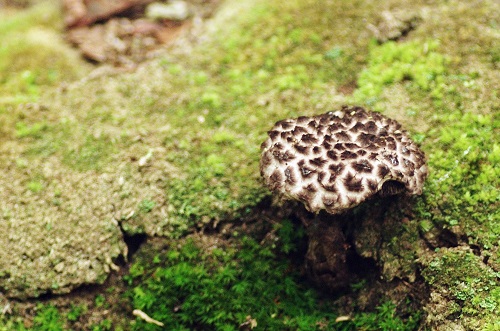
This interesting mushroom looks like its name! The black spores and gills beneath the cap are distinct and, when that stem is cut, there will be a pinkish red color inside.
(posted 9/28/2017)
Wood Stork
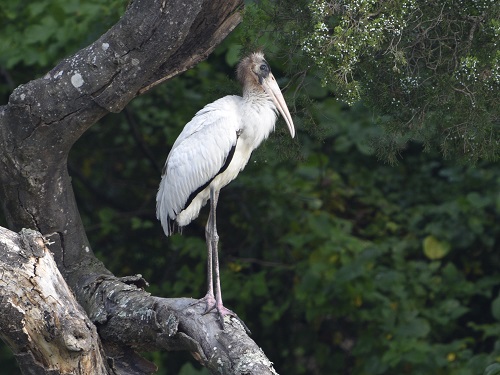
Wood Stork (Mycteria Americana) Hartshorne Woods
The wood stork is a large, white wading bird that is usually found in the southeastern wetlands of the United States. It stands about 40 inches tall, has a wing span of 50 inches and weighs about 5 pounds. The head of a mature wood stork is bald - similar to a vulture. This is the only stork that breeds in the United States. Wood storks can live up to 20 years and pairs often mate for life. The US population was recently (2014) changed from endangered to threaten with an estimated population of about 8,000 pairs. There is a large breeding population from Central American to Argentina that is listed as “least concern” with a breeding population of 32,000 to 46,000. This year there have been multiple sightings of wood storks in New Jersey from Sandy Hook to Cape May. NJ Audubon has recorded sightings dating back to 1994. The last accepted sighting was in 2014. This juvenile wood stork was photographed at the pond in the Claypit Creek area of Hartshorne Woods Park by park patron Michael Mottl on Sept. 14, 2017. (posted 09/18/17)
What Is It?
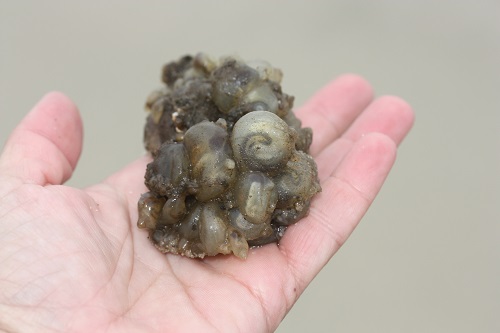
“It” washed up on the beach at Bayshore Waterfront Park. It was a rubbery, sticky glob of … something. Something that was obviously a living creature. How exciting! “It” is a cluster of sea grape tunicates (Molgula manhattensis). These small, round animals are filter feeders and live attached to rocks, boats, sand and docks. You can see two tiny bumps on each of the round bodies in the photos. These bumps are “in” and “out” siphons used by the animals to pump water through its body for filter feeding. They are very hardy and are extremely tolerant of murky or polluted water.
This species was first reported in Long Island Sound in 1838 and is now found from Maine to Louisiana. It is native to the Atlantic and is commonly found in this area and in Europe. Unfortunately, it is also becoming common in areas of the Pacific where it is not native. There, the sea grape tunicate is considered a secondary threat level – not a top priority but becoming problematic. While they don’t look very threatening, they are particularly prolific spawners, in some cases, reproducing once every 24 hours when the water temperature warms to the right conditions. Because of this they can outcompete native organisms for food and space.
The variety of life on this planet is simply amazing! That this clump of ... something … turned out to be a group of animals is another reminder of this. It is why nature is something that is always fascinating and never, ever boring! (posted 9/13/2017)
Country Gait Trail
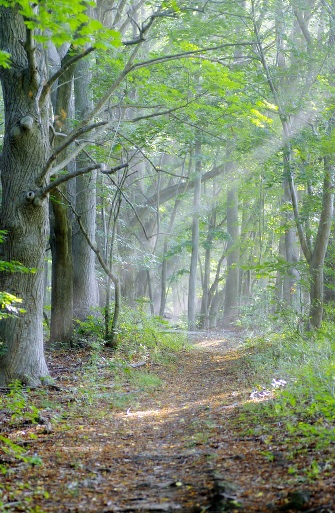
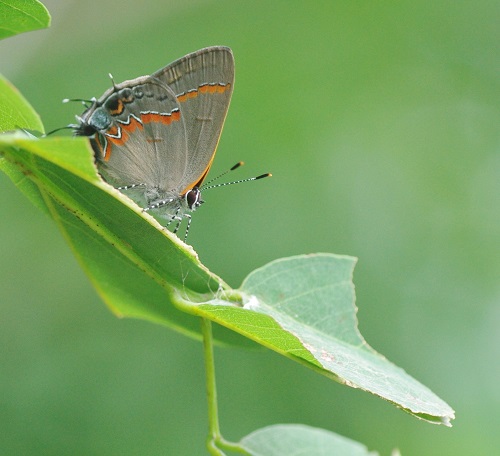
Early mornings and evenings are magical times to visit woodland trails like Country Gait Trail at Huber Woods Park, Middletown. The mornings are misty at this time of year and trails like this one truly come to life. Country Gait Trail travels through open meadows, forest and allees for approximately one mile. Rated ‘moderate’ due to some grade changes and roots and rocks creating an irregular surface, the trail is suitable for walkers, hikers and horses but not recommended for bikes. While in the meadows along Country Gait Trail, keep your eyes out for butterflies like this red banded hairstreak. (posted 8/30/2017)
Mushroom or Plant?
While often mistaken for a mushroom, this interesting organism is a plant. What you are seeing in this photo are the flowers of an underground plant called a Ghost Pipe. It is a parasitic plant growing off the roots of other plants. It is white because it lacks the green pigment that most plants have that allows them to make their own food. Ghost Pipes, therefore, must draw food off another source. In our area that tends to be the roots of nearby trees. Ghost Pipes are common in the woods at
Huber Woods Park. (posted 8/24/2017)
There is a Fungus Among Us!
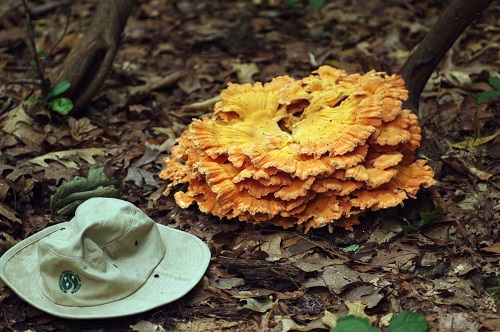
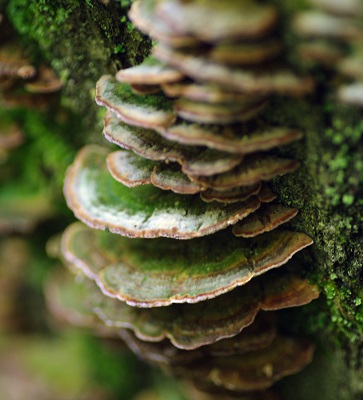
The warm, wet humid weather we have had recently is perfect for fungi and they are showing up in all their glory in our parks. While I have seen a wide spectrum of fungi – slime molds, jelly molds, mushrooms, shelf fungi and more within the last week, this post explores shelf fungi. Most people mistake the mushroom, or other visible portion of a fungus such as the shelf of a shelf fungus as the entire organism. However, the main ‘body’ of the fungus is like the stem, leaves and roots of a plant. The mushroom part is like a flower of a plant. It is for reproduction and spreading spores, which are similar to seeds. The majority of the fungus is underground or within the wood of a tree and the structure you see is a small part of its body, just like a flower is a small part of a plant. And, just like there are different types of flowers, fungi have different types of reproductive structures. The ones here represent shelf fungi and are usually found growing on dead or dying trees. The body of the fungus consumes the dead wood of the tree, breaking it down and returning it to the soil. The shelf structures have a solid, sturdy top side to protect against damage. The underside has gills, pores or teeth that grow and distribute the spores. A couple of the many types of shelf fungi found along our trails are pictured here. These photos were taken within the last seven days at Huber Woods Park. If you are interested in seeing some of these interesting organisms, grab your mushroom ID book and hit the trails! (posted 8/23/2017)
Imperial Moth at the Monmouth County Fair
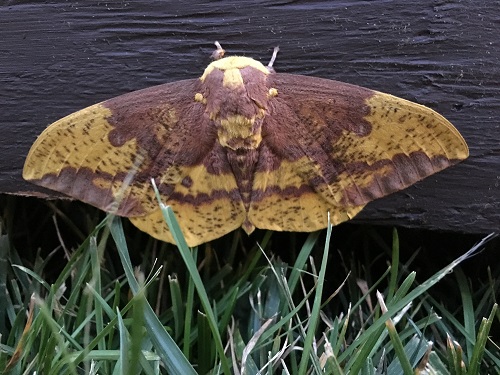
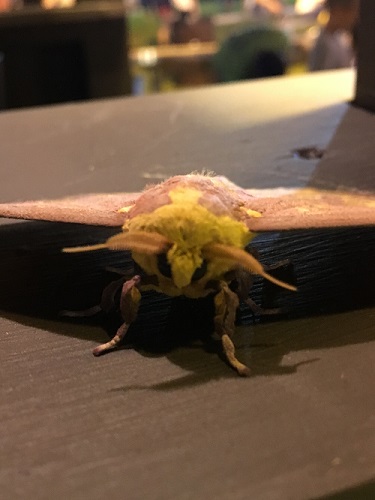
Humans are not the only creatures enjoying the sights and sounds of this year’s 43rd Annual Monmouth County Fair! Staff found this male Imperial Moth observing the fun times being had by the participants at the Monmouth County Park System’s climbing wall. Front gate staff report that these moths are often observed in the parking areas at the Fair. The male of this species can be distinguished from the female by their antennae which is quadripectinate for the basal two-thirds and simple for the remaining length (more feather like from the base of the head, being thinner at the tip). Female antennae are simple (thin) through the entire length. The male also has a heart shaped marking on its abdomen, like we can see on this specimen. After viewing the climbing wall, this Imperial Moth headed toward the back of the Fairgrounds, perhaps to observe some of the delicious food offerings and the main stage entertainment! (posted 7/31/2017)
A Seahorse Found at Bayshore Waterfront Park
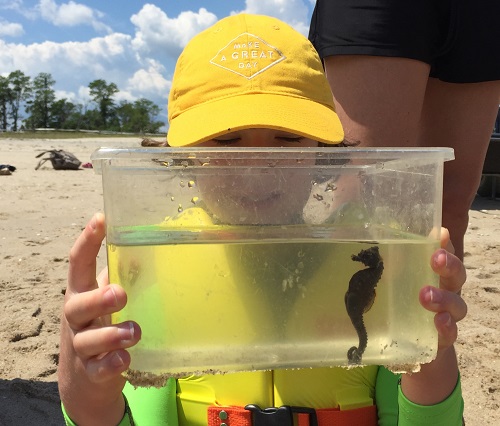
Some days everything seems to come together. It was the first day of summer and the first week of free seining at the Bayshore Waterfront Park when a Northern Lined Seahorse was discovered in our seine net. Seahorses appear almost as mystical creatures like unicorns, but seahorses really do exist. The Northern Lined Seahorse is our only native seahorse along coastal Monmouth County. Seahorses like to cling to pilings or vegetation as they suck in small shrimp and plankton with their head shaped like a horse’s head. Free seining takes place every Monday, Wednesday and Friday from 11 a.m. to 12 p.m. at the Bayshore Waterfront Park until Friday, August 25. No reservations necessary. Every catch is different, who knows what we will find next in our net. It’s fun for everyone. Posted June 21, 2017
Ruby Throated Hummingbird Nest at Manasquan Reservoir
This female Ruby-throated hummingbird has nestled down and is waiting for her eggs to hatch. She selected only the best materials for her nest - cattail fluff and dandelion down for softness, lichen for structure and camouflage, and spider webs to bind it all together. The nest is the size of a ping pong ball. She may lay up to 3 eggs each the size of a tic-tac. Three newly hatched chicks can weigh less than a dime. Ruby-throats incubate for 11-16 days and fledge at about 21 days old. These birds will not use a bird house. They feed on nectar and insects and are significant pollinators. (posted 6/1/2017)
Turkey Swamp Salamanders
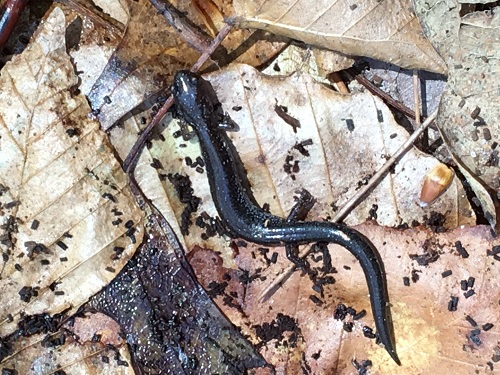

Manasquan Trail, at Turkey Swamp Park, Freehold
April 28, 2017 - Salamanders are often one of the most abundant organisms in a forest ecosystem, but are rarely sighted by casual hikers. Typically they will be found in the leaf litter or under fallen logs. In this particular situation these two red-back salamanders were found under a log. The red-back comes in two forms a redback (reddish stripe down back and black to gray sides) and leadback (black to gray that blends with sides) form. It should be emphasized that great care must be taken when searching for salamanders (or any animals) and anything moved needs to be replaced as found. (posted 5/2/2017)
Video of the Eagles' Nest
Two Eaglets Confirmed!
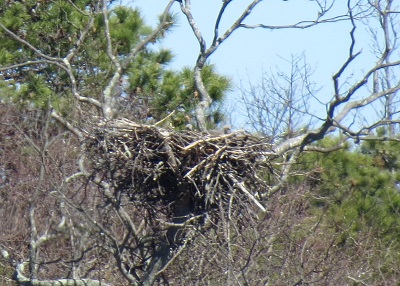
It’s been confirmed! There are two bald eagle chicks in the nest at the Manasquan Reservoir, Howell. They hatched on March 7 and are approximately three weeks old. Currently downy grey, the chicks will quickly turn black as their feathers develop. The chicks are growing very fast and will be almost as large as their parents in six weeks. Their arrival is especially exciting since it marks the first time eaglets have hatched at the Manasquan Reservoir since 2014. (posted 3/30/2017)
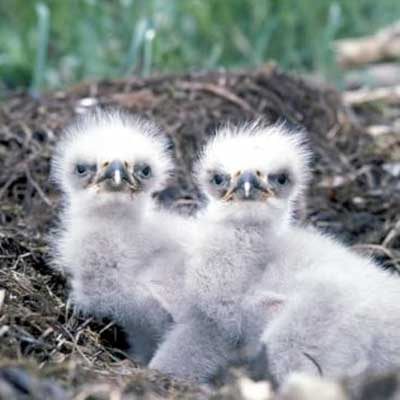
At the Manasquan Reservoir Environmental Center, we’ve been watching the eagles’ nest in anticipation of their eggs hatching. This morning we observed the adult eagles reaching down into the nest and (presumably) feeding a chick. This behavior tells us that at least one chick has hatched. Eagles typically have between 1 and 3 chicks per season. It will be about two weeks before we know how many eaglets are present. It takes this long for the chicks to grow enough to hold their heads above the nest edge.
The nest can be seen from the Manasquan Reservoir Environmental Center, weather permitting. Please remember that nesting is an extremely sensitive time for eagles. A nest can fail with disturbance including people try to get too close. Please do not approach the nest. (posted 3/7/2017)
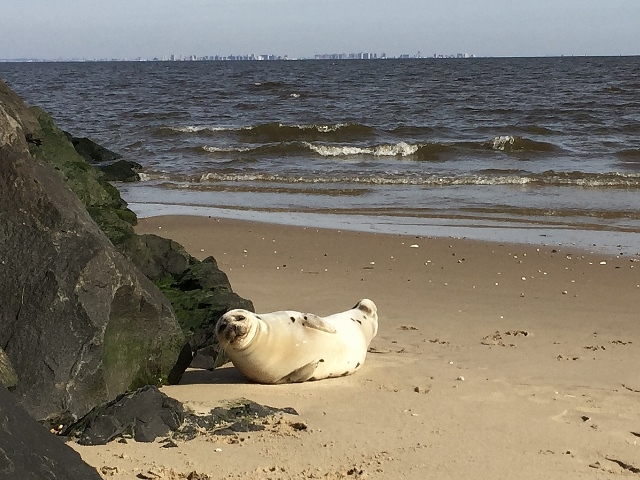
Recently, a juvenile harp seal was seen by Park System staff at Bayshore Waterfront Park, Port Monmouth. This marine mammal was resting on the beach after what was probably a busy night foraging for fish in Sandy Hook Bay. Harp seals are highly migratory species, and have been known to travel over 1,500 miles away from home in the chilly waters of the Arctic and North Atlantic Ocean to feed. The NJ Marine Mammal Stranding Center was notified of the seal's whereabouts in case the seal becomes ill or needs assistance in the near future. (posted 2/21/2017)
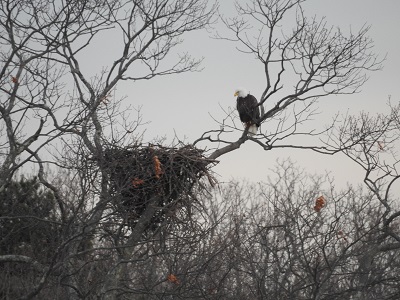
UPDATED - Good news! The Manasquan Reservoir eagles are incubating as of January 27. Post Hurricane Sandy (October 2012), this date is within their typical range to start incubating. If all goes well, hatching should be around the second week of March (35 to 40 days out). The nest is easily seen from Georgia Tavern Road and can be viewed on a television monitor inside the Manasquan Reservoir Environmental Center, weather permitting. (posted 2/8/17)
The bald eagle pair at the Manasquan Reservoir in Howell has been busily building a new nest. Since Hurricane Sandy in 2012, they have relocated their nest four times. The male eagle selects the nest location, and each nest has been within close proximity of the other. Both eagles share in building the nest. They have been seen bringing material, arranging it, and occasionally have disagreements on optimum placement of sticks. Staff and volunteers are watching for signs of the next phase: egg laying and incubation. In recent years, this has been late January or early February. The nest can be easily viewed from the walking path adjacent to Georgia Tavern Road or from inside the Manasquan Reservoir Environmental Center, weather permitting. (posted 1/11/17)
Back to Nature Now